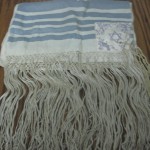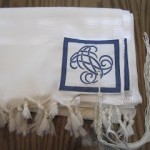
The Spanish and Portuguese Jews of London comprise the oldest Jewish community in Great Britain. They have a number of beautiful and unique customs, some of which are apparently rooted in pre-expulsion Spain, but also influenced by the Italian and Spanish-Moroccan rites.
According to Rabbi Jonathan Cohen, during the course of their 350-year sojourn in the British Isles, they have continued to evolve, developing an British-Sephardic character of their own, “distinct from that of their ‘parent’ congregation in Amsterdam, or of their ‘sister’ congregations in New York, Philadelphia and elsewhere.”

Like many other Jewish communities, the Sephardic and Portuguese Jews of London referred to the prayer shawl as a “tallet” – not a “taleet.”
The tzitzit were tied with 10-5-6-5 windings, rather than the 7-8-11-13 configuration, which developed later. Another detail that distinguished their tallet from today’s typical prayer shawls was the absence of an atara, or neckband. (Notably, to this day the Chabad tallis does not have an atara.)The tallet was often made of silk, with blue striping, and had embellished, oversize corner patches, like the Yemenite tallith.


(7) Comments
Isn’t there an issue of tartei d’satrei with the tzitziot being wool while the beged is silk?
Nope. Tartei d’satrei comes into play when you have two halachic conflicting opinions and you make use of both simultaneously. But in the case of tzitzit it’s just a question of what type of tzitzit are suitable for various types of garments.
The Shulchan Aruch states clearly that you can always put wool tzitzit on any type of garment. Thus if you have a cotton garment you can use cotton or wool tzitzit, if you have a silk garment you can use silk or wool tzitzit, etc.
Today 99% of all tzitzit strings are made of wool. (If you find “cotton tzitzit” online, that really means a cotton garment with wool tzitzit.) If you have a silk talit and you want to tie on silk tzitzit, you’re probably going to have to spin the strings yourself.
As I recall, the Rama’s hagaha there (I think it’s OC 8 or 9) says that there is a preference for tzitziot of the same material as the beged.
I once got a call from someone who wanted cotton tzitzit strings for this reason.
Were you able to figure something out? I have seen one place which claims to sell linen tzitziot, however as far as I’m aware, it is not ideal to use linen and they don’t have a hashgacha on their strings.
So which talet do you recommend so that it can be worn in this style?
Any size 36. You might want to refer to this newer post on an S&P talet we recently started offering our customers.
Comments are closed.